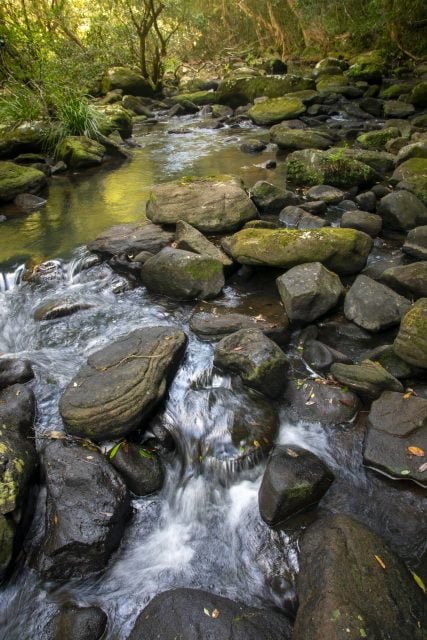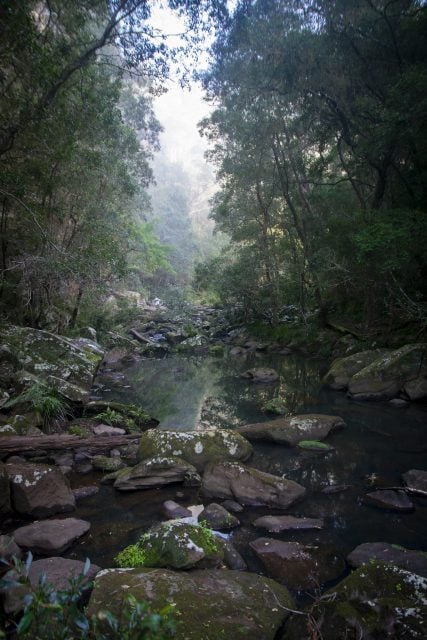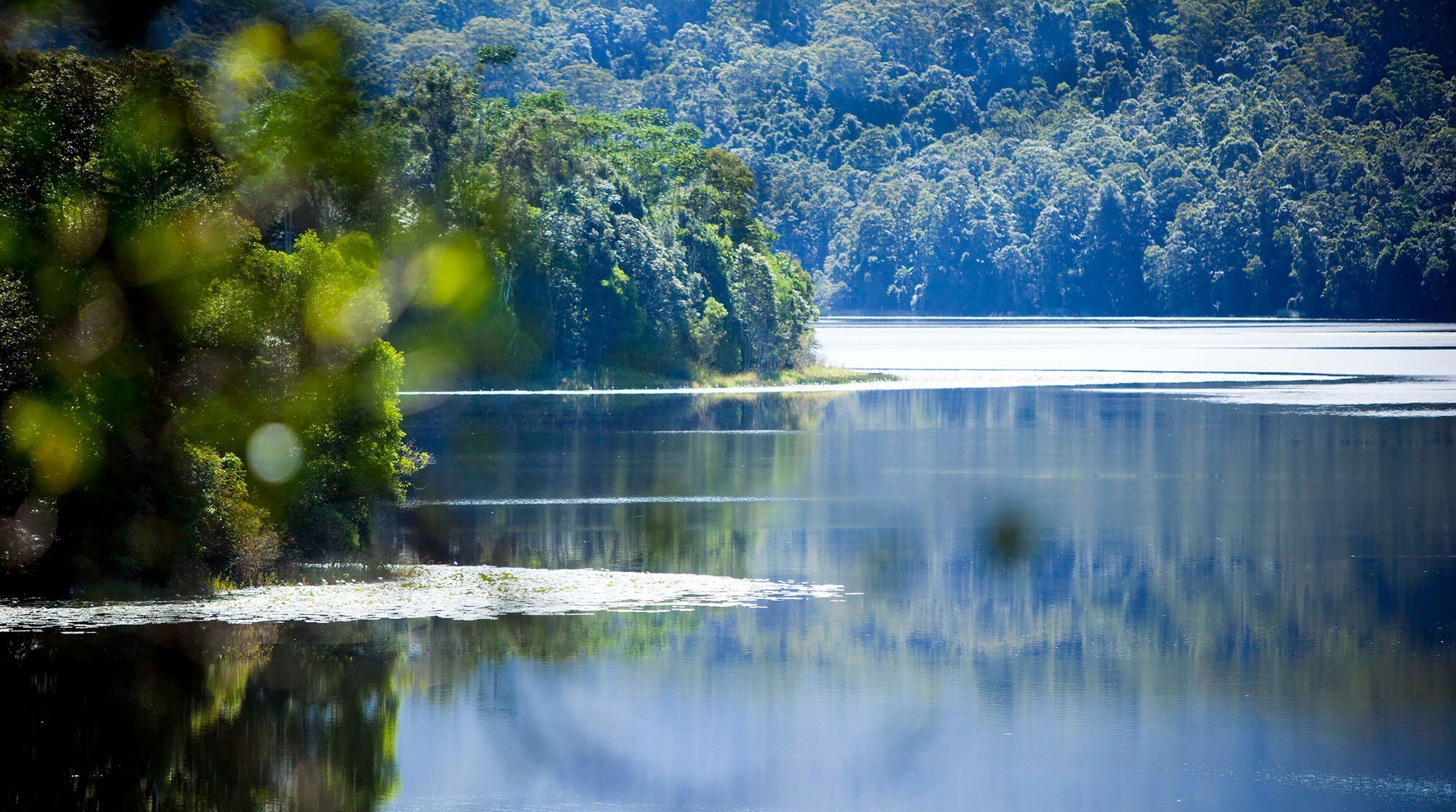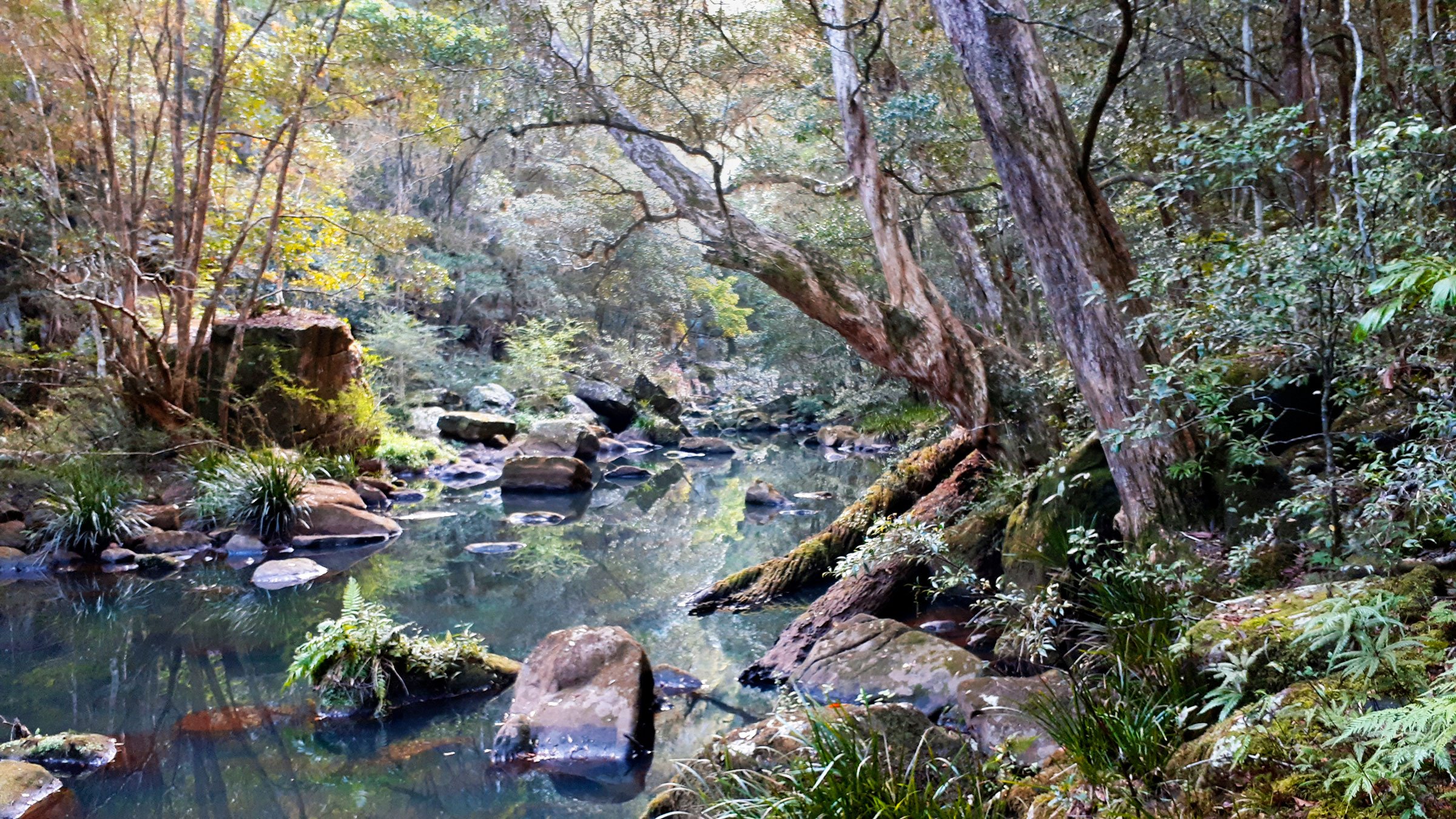
Story and photos David Lowe
With public submissions about to close on the Rous Future Water Project 2060, Echonetdaily sat down with two legendary Northern Rivers protectors to get their views on the proposed Dunoon Dam.
Nan Nicholson is particularly concerned about the ecological impacts and threats to First Nations heritage, having spoken to some of the Widjabul-Wyabul people who are directly affected.

‘What they’re most upset about is the process that Rous has gone through,’ she said.
‘It seems to be a common white problem – they just ignore Aboriginal people, and this is really happening with Rous.
‘Because Rous is acting like just a water-seller, that’s all they have to do, they don’t have to take any of the non-monetary values into account.
‘And because you can’t put a money value on the Aboriginal heritage or the ecological heritage, it just doesn’t count.
‘Rous is saying, we’ll listen to you and do all this extended consultation period, but basically that is code for, we will do what we like and we’ll ignore whatever you want.’
Living heritage

‘The cultural heritage assessment that was done for Rous was so strongly worded, saying that this place is extremely significant, and there’s no doubt about that,’ said Ms Nicholson.
‘It was one of the most strongly worded documents that [former EDO solicitor] Sue Higginson’s ever seen.
‘And it wasn’t just saying that the stones and bones are important, or even that the burial sites are important.
‘What they were saying is that this is living heritage – these people are connected to this place in a living way. It’s extremely important, and we cannot just thrust it aside.
‘I think it’s insulting in the extreme to tell Aboriginal people that we’ll talk to you, and then we’ll ignore what you say.’
A Rio Tinto moment?
Nan Nicholson acknowledges the complexities of who is entitled to speak about what and when in Aboriginal society, but says, ‘Rous is using this as a way of not actually talking to anyone in particular.
‘The people I have spoken to are very upset, and they’re calling this a Northern Rivers Rio Tinto moment, because the burial sites and the artifacts amount to an ancient heritage that is being swept aside by white desires, yet again.’

Ms Nicholson says she particularly takes issue with the term ‘Aboriginal stakeholders’, saying this doesn’t do justice to the level of connection.
‘These are custodians,’ she said.
‘They’ve been looking after this place for thousands of years. It’s not up to us to walk in and say, what you think doesn’t count any more.’
Annie Kia’s view
Ngara award winner, anti-gasfields campaigner and local resident Annie Kia has blogged about the Dunoon Dam proposal.
She told Echonetdaily, ‘I think the tragedy of this situation is that Rous is proposing to build a dam that will destroy many hectares of farmland and rainforest and Aboriginal heritage, so that councils can continue with poor water management.
‘The more we learn about this, the more we discover that the water system is broken,’ she said.
‘Rous County Council is the bulk supplier of water, and we have four local governments, all of whom sometimes have good local policy to do with water, and sometimes waste water. Too often, it’s the latter.’

Ms Kia mentioned the example of Lismore City Council’s proposal for development at North Lismore Plateau which included no plans for re-use water through the purple pipe system.
She said another example is in Byron shire, where the new waste water treatment plant ‘did a great job’, but generated a problem of how to dispose of the resulting water, with no plan to connect it through the purple pipe system to the proposed greenfields housing development at West Byron.
‘There are further examples that are replicated in decisions large and small, where we just don’t optimise water in our system,’ she said.
Waste not, want not
‘When we talk about systemic waste in the system, we’re not just talking about leaky pipes,’ said Annie Kia.
‘We’re talking about poor decisions that are made over and over and over again, the end result of which is that we throw good water away.
‘On average, we use in our region 160 litres per person per day, yet a person can only ingest 2.5 litres of water! It’s raised to the highest level of drinking water standard, but yet we use it to flush poo down toilets, to mix cement, and clean driveways and to do all sorts of things.

‘This is really not a sensible way to manage water, and we need to value water at every single point of its journey through our water system. And there are many ways that we can do this.’
Ms Kia argues that the Dunoon Dam might look like a simple solution from an engineering perspective, ‘but it’s actually an excuse so that councils can continue their wasteful water practices.
‘What we need is a commitment from all those interlocked entities (Rous the bulk supplier and the four local government areas) to value water at every part of its journey.
‘Should the dam go ahead, it’s a green light for councils to continue with business as usual,’ she said.
Ecology
Nan Nicholson and her partner Hugh Nicholson have literally written the book on Australian rainforest ecology (in fact many of them). Echonetdaily asked her about the ecological impact of the proposed dam.
‘Because I’m a rainforest botanist I have an extreme interest in this, and have had for many years,’ she said.
‘I recently realised how important this particular bit of rainforest is. It’s part of the Big Scrub, and the Big Scrub has been reduced to 1% of its former extent, there’s about 940 hectares left.
‘And the amount of rainforest proposed to be cleared for this proposal is about 55 hectares, and half of that’s going to be demolished. So 55 hectares works out to be over 5% of the remaining Big Scrub, which has been reduced to 1%.
‘It might not sound much, but actually it’s incredibly critical, particularly because it’s in two large blocks, and most of the Big Scrub remnants are just tiny little patches.
‘I don’t think Rous can, like the Aboriginal heritage, just sweep it aside and say it doesn’t matter,’ she said.
A unique forest

‘What’s even more important about this bit of rainforest, is it’s recognised as an endangered ecological community,’ said Ms Nicholson, ‘and that’s not just an empty term, it means it’s extremely important in legal terms.
‘Not just locally, but regionally and statewide, and even Australia-wide. There’s nothing else like this forest right here.
‘One of the reasons that’s true is that of the temperate rainforest to be cleared, seven hectares is on sandstone.
‘And almost all of the other warm temperate rainforest in this area is on rhyolite, on the volcanic upper valleys of the area.
‘This particular bit is on a sandstone gorge, which is really exceptional. And because it’s a poorer soil it doesn’t have much weeds, and it wasn’t heavily cleared, because it was steep and it wasn’t so fertile. It was largely left alone.
‘So this forest type is extraordinarily important in its own right. And they’re going to clear six hectares of the seven hectares of this type. It is just beyond belief that you could do this to a rainforest that just doesn’t occur anywhere else.
‘It’s tantamount to scientific vandalism. Just to say, this can go, we can never look at it again, we can’t rehabilitate it, we can’t do anything. When it’s gone, it’s gone.
‘And to add insult to injury, Rous is proposing that we do offsets, but you can’t offset something that’s unique.
‘What they’re proposing is to offset this priceless rainforest in sandstone, with regenerating the weedy slopes, and taking hundreds of years to get them back into rainforest, on a different soil type, with a different type of rainforest.
‘They’re saying that’s equivalent. It just does not stack up. It’s embarrassing that they would suggest that, because it’s so ludicrous.’
Alternatives?
Annie Kia told Echonetdaily Rous County Council have not considered, or costed, some of the most cost-effective options for future water.

‘One of the things we have discovered through making contact with Professor Stuart White at the UTS in Sydney, who is an expert on water management, is that huge gains can be had from an approach called system-wide water efficiency.
‘This is an audit of every part of the water system; every council long pipe, every facility, every school, every industrial user; and in those places every faucet, every appliance, every policy and every behaviour in that place.
‘Having done that audit we then fix it, at every point of water’s journey,’ said Ms Kia.
‘Rous did not analyse or cost this intervention, so they can’t possibly say that the dam is the best option. They actually don’t have that to compare it with, what sort of an investment that would be.
That kind of investment involves putting dollars into that, because the fix-it job involves people doing the retro-fit, whatever is necessary, and that generates a lot of jobs for people. These are good jobs that we need in our region.’
The winner is Sydney
Professor White is in discussions with Rous County Council and has made a public analysis of the existing Rous Future Water Project and ways it could be improved here and here, referencing his work with system-wide water efficiency in Sydney.
‘Sydney Water used this approach,’ said Annie Kia, ‘and through doing that they were able to add 950,000 people to their population, nearly a million people, without any increased water usage in the population. If they can do that, we can do that too.
‘What we want is for Rous to analyse and cost what this kind of investment would involve.
‘And we want a commitment to getting smart about water, and really smart water management in all the local governments, because we can do better than this.
‘I think people instinctively don’t like waste,’ she said. ‘Would we destroy this priceless rainforest, this little portion that’s left of the Big Scrub, would we destroy that and destroy good farmland so that councils can continue wasting water?’
Koalas

Although koalas have no voice in the public submission period for the Dunoon/Channon Dam, Nan Nicholson believes the species will be disastrously impacted if the project goes ahead.
‘The Channon is a known hotspot for koalas, and the terrestrial ecology impact assessment makes clear that there are existing corridors that koalas use that will be severed by the dam.
‘We know that koalas are already on the road to extinction, so it’s unconscionable that you would do anything that would affect koala viability in any way.’
She said Rous’s proposed mitigation strategy was ridiculous, such as the idea of a fauna ecologist on site for ‘salvage’.
‘When you’re clearing these trees you salvage these koalas and things dropping out of the tree and take them into care, I suppose. This is seriously one of their mitigations.
‘So I can see that either Rous or the authors of this report, the terrestrial impacts assessment, do not have a clue about what’s going on.’
Colossal impact

Ms Nicholson told Echonetdaily the flora and fauna impacts would be ‘colossal’, with numerous threatened species in the gorge not being correctly identified.
Frogs and water gums are a particular concern.
She said there are strange and unique combinations of flora in the area to be destroyed, with Rous relying on lack of public knowledge of what is there, and difficulty of access (the gorge is surrounded by private property), to prevent public outcry.
‘It’s a tricky thing,’ said Ms Nicholson. It’s good to let people know from above what it looks like, but we don’t necessarily want a lot of people walking in.
‘This is a conundrum Koori people have. Do you tell people, who might trash it, or do you not tell people and risk it being trashed? Which is correct?

‘But I think this place is utterly priceless, and it should have been a showstopper. In fact it was, ten years ago when a public reference group that I was a member of went through all these things.
‘The ecological values and Aboriginal values were considered to be an absolute showstopper, and this dam could not go ahead,’ she said.
‘So I have to ask, what has changed? Why are those things of no value?’
Creativity
According to Annie Kia, ‘Organisations don’t get creative until they experience some constraint on themselves.
‘A great example is when the state government said to all the local governments, you are about to experience a terrible financial pain for every tonne of landfill.
‘The next thing that happened is Lismore City Council suddenly did the most creative stuff with landfill.
‘I have a sense that in all these local government areas there are creative ideas for what to do with water in the third drawer of the desks,’ she said.
‘They’re either great ideas or half-finished projects, and what we need is to get those projects out of the third drawer and on top of the desk and have six people round the desk making the thing happen!
‘We are never going to get a system for water that is fit for purpose for the 21st century, we are never going to have innovation in our water system if we spend $240 million dollars or more on this massive last-century dam,’ said Ms Kia.
‘It will suck up all the resources and it will forever blight our ability to have smart water management in our local government areas.’
More time needed?
Annie Kia and Nan Nicholson noted there are numerous other major issues associated with the proposed dam, including downstream flood risk, sediment, road damage and sustainability, with more time needed for the community to come to grips with what is being proposed.
‘The people of Dunoon and the Channon who love and know Rocky Creek intimately are extremely distressed about this, because they know what destruction is entailed with this plan,’ said Ms Kia.
‘As more people in the region become aware of the incomparable preciousness of what’s in the gorge and in the area to be flooded, we think that they will understand that we cannot destroy this so that councils can waste more water.’

Nan Nicholson said, ‘Here in the Northern Rivers, we think of ourselves as being progressive, and we have a lot of water here compared to most of the state.
‘If we can’t figure this out without building another dam, what hope is there for other regions?’
The Rous Future Water Project 2060 is currently on public display, with a decision due before the end of 2020.
Public comments are welcome, and can be made until the evening of Wednesday 9 September here.
You can see more of the country that would go underwater if the dam is built here.
Below is a spectacular new short film from Aerial Punkin showing some of the wild country and farmland along Rocky Creek which would be inundated if the dam proceeds:
More stories about the Dunoon Dam
How to supply water to the increasing population?
It is predicted that the next 40 years will see the demand for water increase by 50 per cent in the local government areas that Rous County Council supply with water.
Is our drinking water supply threatened by Dunoon Dam?
Most people don’t know that the proposal for Dunoon Dam has never been part of Rous County Council’s 40-year, adopted, strategic plan to increase water supply, resilience and security, known as Future Water Plan 2060.
Will the Dunoon Dam go ahead?
We have not heard much about the Dunoon Dam lately and many people are asking ‘What is happening with that dam?’
Mullum’s future water supply still uncertain
What is the best way to secure a long-term, reliable water supply for Mullumbimby?
Tumultuous first year for Ballina’s Mayor Sharon Cadwallader
Floods, COVID and a regional housing crisis added up to a very eventful first year in the big chair for Mayor Sharon Cadwallader at Ballina Shire Council, following the departure of David Wright. This is part one of a two part interview with Cr Cadwallader, focusing on 2022. Part two will focus on 2023, and beyond.













Nan & Annie have figured it out. You cannot put
a price on a rainforest. And ‘water is life’.
A humble house size of 12 meters X 12 meters = 144 square meters of rainwater collection.
Only one inch or 25mm of rain, will drop 3.6 tonnes or 3,600 liters of water on such a roof, which is a huge amount of usable free water.
(There are 40 inches in a meter. 144 / 40 = 3.6 cubic meters)
This is what we as a species, can easily achieve, especially in the Northern Rivers.
The Dunnon Channon dam is therefore unnecessary.
Let’s all belong more to this precious planet, instead of stomping our ugly human footprint even more egoistically upon it.
Great article, the huge big dam in one of the most beautiful parts of the northern rivers is not only not needed but would destroy this precious area, those photos and video are amazing. It’s hard to imagine that area being lost and hundreds of millions of dollars being spent when there are clearly more practical ways to better secure our long term water needs.
The Northern Rivers receives one of the highest and most consistent rainfalls in NSW. There are other regional areas such as Orange, Dubbo, Armidale that actually have serious water security issues. We don’t.
Optimising current water supply infrastructure, fixing the leaks, compulsory re-use for new subdivisions, more rainwater tanks, better demand management and efficiency initiatives, etc. There is a lot more that can be done without flooding this special place.
I read no further than “huge big dam.” Grow up.
That creek is in really good ecological condition – I spotted hardly any weeds!
Building dams should be a solution of last resort – after all water efficiency measures, reuse, recycling, rooftop harvesting etc. have all been implemented.
Building dams at the expense of scientifically and culturally priceless rainforest; to destroy what is obviously priceless natural heritage, when no other solutions have even been costed, is absurd to the point of being reckless. It is a stupid, block-headed “solution”. Just some lazy ecological vandalism…
I would rather drink recycled water than destroy even a hectare of the tiny amount of rainforest that has survived European colonisation…
What is wrong with our council ?
Why are we not leading Australia in environmental solutions and sustainable concepts ?
Sack the council. This is an outrage